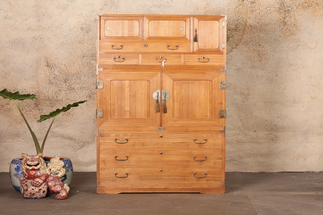Jan 15th 2025
The History and Evolution of Japanese Tansu Chests
Japanese tansu chests are a quintessential symbol of Japanese craftsmanship, reflecting centuries of cultural heritage and artisanal mastery. These exquisite pieces of furniture are not just functional but are also revered as works of art, embodying the minimalist yet intricate aesthetic that defines traditional Japanese design. Today, tansu chests hold a special place in the world of Asian antique furniture, attracting collectors and enthusiasts alike.
Origins of Tansu Chests
The term “tansu” originates from the Japanese words “tan” (meaning storage) and “su” (meaning chest). Tansu first emerged during the Edo period (1603-1868), a time of prolonged peace and economic growth in Japan. This era saw a burgeoning merchant class, which spurred the need for portable, durable, and aesthetically pleasing storage solutions.
Initially, tansu chests were crafted for practical purposes—to store clothing, documents, and household items. They were designed to be lightweight and portable, with some chests featuring handles for easy transportation. Over time, these utilitarian pieces evolved to reflect regional variations, social status, and specific functions.
Materials and Construction of Tansu Chests
The construction of tansu chests showcased the remarkable skill of Japanese artisans. Traditional tansu were made from woods such as keyaki (zelkova), sugi (Japanese cedar), and kiri (paulownia). Each type of wood was chosen for its unique properties:
- Keyaki was prized for its strength and beautiful grain patterns, often used for high-end pieces.
- Sugi offered a lighter weight, making it ideal for portable tansu.
- Kiri was highly resistant to moisture and insects, perfect for storing valuable items like kimonos and documents.
Artisans employed joinery techniques that required no nails, relying on wooden joints and dowels for assembly. This method ensured the durability of tansu while allowing for flexibility and ease of repair. The hardware, often made of iron or brass, added both functionality and decorative appeal. Intricate handles, locks, and corner brackets were carefully crafted to enhance the overall aesthetic.
Types of Tansu Chests
Tansu chests were designed to serve various purposes, resulting in a wide range of styles and forms. Some of the most notable types include:
- Isho Tansu: Used for storing clothing and personal items, these chests often featured multiple drawers and compartments.
- Kaidan Tansu: Also known as staircase chests, these unique pieces doubled as steps and storage, commonly found in homes with limited space.
- Choba Tansu: These were merchant chests used to store business records, money, and valuables. Often placed in shops, choba tansu were designed to impress clients with their intricate craftsmanship.
- Funa Tansu: Portable ship chests designed for sailors, funa tansu were compact and sturdy, featuring secure locks to protect valuables during voyages.
- Mizuya Tansu: Used in kitchens, these chests provided storage for utensils, dishes, and cooking supplies.
Each type of tansu reflected the needs and lifestyles of the people who used them, as well as the specific regional characteristics of their origin.
Regional Variations
The design and construction of tansu chests varied by region, influenced by local materials, traditions, and cultural preferences. For example:
- Sendai Tansu: Known for their elegant keyaki wood and lacquer finish, these chests often featured intricate metalwork.
- Kyoto Tansu: Characterized by their refined simplicity, Kyoto tansu embodied the minimalist aesthetic of the region.
- Echigo Tansu: Made from sugi wood, these chests were known for their robustness and rustic charm.
The Decline and Revival of Tansu
The Meiji Restoration (1868-1912) marked a period of rapid modernization in Japan. As Western-style furniture gained popularity, the demand for traditional tansu began to wane. Many tansu chests were repurposed or discarded, leading to a decline in their production.
However, the 20th century saw a renewed interest in Japanese antiques, including tansu chests. Collectors and designers around the world began to appreciate the historical and artistic value of these pieces. Today, tansu are celebrated not only as functional furniture but also as cultural artifacts that offer a glimpse into Japan’s past.
Tansu in Modern Interiors
In contemporary homes, tansu chests have found a new life as versatile and stylish furniture pieces. Their timeless design and compact form make them ideal for various spaces, from living rooms to bedrooms. Incorporating a tansu chest into modern decor adds a touch of elegance and history, bridging the gap between traditional and contemporary aesthetics.
Care tips for Tansu Chests
Preserving the beauty and functionality of a tansu chest requires proper care. Here are some tips:
- Avoid Direct Sunlight: Prolonged exposure to sunlight can fade the wood and damage the finish.
- Control Humidity: Keep the chest in a stable environment to prevent warping or cracking.
- Clean Gently: Use a soft, dry cloth to dust the surface and avoid harsh chemicals.
- Protect the Hardware: Periodically check and clean the metal fittings to prevent rust.
Explore Some of The Best Japanese Chests at Eastern Classics!
Japanese tansu chests are more than just storage furniture; they are a testament to Japan’s rich cultural heritage and artisanal excellence. From their origins in the Edo period to their revival in modern interiors, tansu chests continue to captivate and inspire. As prized examples of Asian antique furniture, they offer a unique blend of history, functionality, and beauty that resonates with collectors and homeowners alike.
Get a tansu chest in your home to celebrate timeless craftsmanship!






